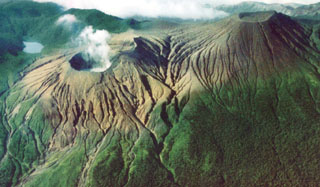Report on Rincon de la Vieja (Costa Rica) — 22 December-28 December 2021
Smithsonian Institution / US Geological Survey
Weekly Volcanic Activity Report, 22 December-28 December 2021
Managing Editor: Sally Sennert.
Please cite this report as:
Global Volcanism Program, 2021. Report on Rincon de la Vieja (Costa Rica) (Sennert, S, ed.). Weekly Volcanic Activity Report, 22 December-28 December 2021. Smithsonian Institution and US Geological Survey.
Rincon de la Vieja
Costa Rica
10.83°N, 85.324°W; summit elev. 1916 m
All times are local (unless otherwise noted)
OVSICORI-UNA reported that at 1015 on 25 December a small eruption at Rincón de la Vieja was recorded for about four minutes but not visually observed due to weather clouds. Rains after the event and continuing early on 26 December washed the acidic sediment deposited from the volcano downstream in the Pénjamo, Azul, and Azufrada drainages, into the aquatic ecosystem. Phreatic events were recorded at 1402 and 1630 on 28 December though weather conditions prevented visual confirmation.
Geological Summary. Rincón de la Vieja, the largest volcano in NW Costa Rica, is a remote volcanic complex in the Guanacaste Range. The volcano consists of an elongated, arcuate NW-SE-trending ridge constructed within the 15-km-wide early Pleistocene Guachipelín caldera, whose rim is exposed on the south side. Sometimes known as the "Colossus of Guanacaste," it has an estimated volume of 130 km3 and contains at least nine major eruptive centers. Activity has migrated to the SE, where the youngest-looking craters are located. The twin cone of Santa María volcano, the highest peak of the complex, is located at the eastern end of a smaller, 5-km-wide caldera and has a 500-m-wide crater. A Plinian eruption producing the 0.25 km3 Río Blanca tephra about 3,500 years ago was the last major magmatic eruption. All subsequent eruptions, including numerous historical eruptions possibly dating back to the 16th century, have been from the prominent active crater containing a 500-m-wide acid lake located ENE of Von Seebach crater.
Source: Observatorio Vulcanologico y Sismologico de Costa Rica-Universidad Nacional (OVSICORI-UNA)

